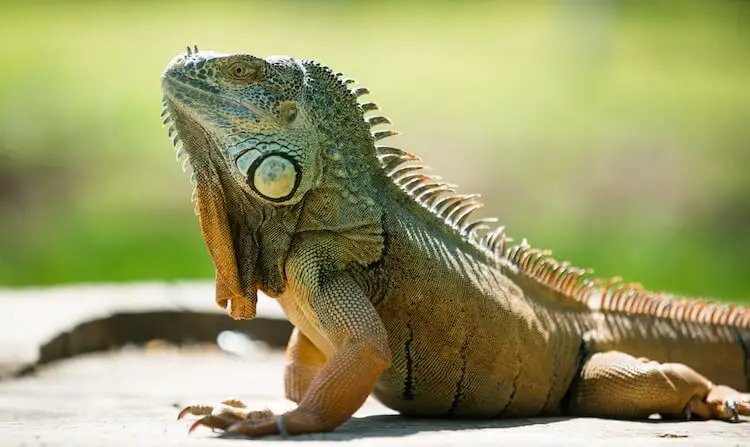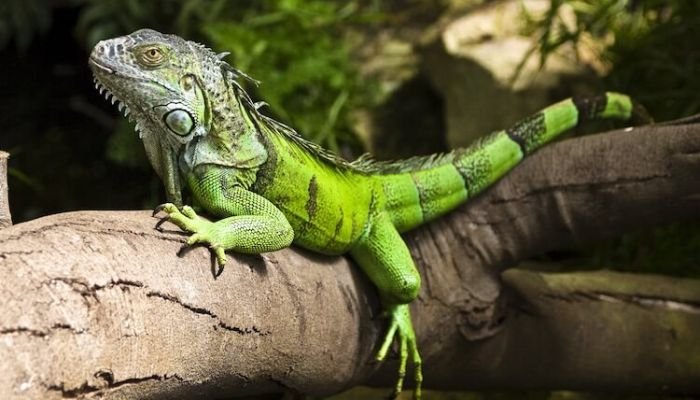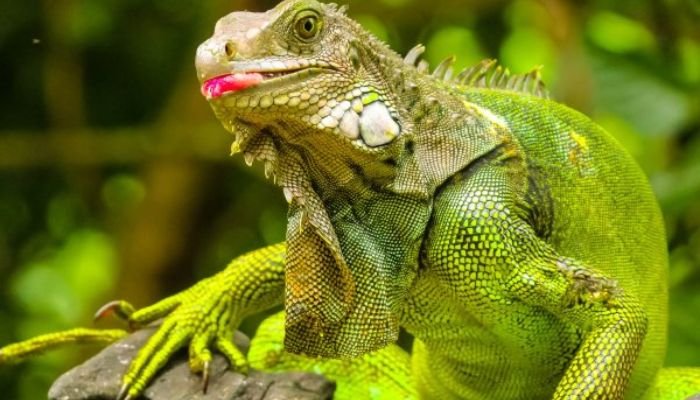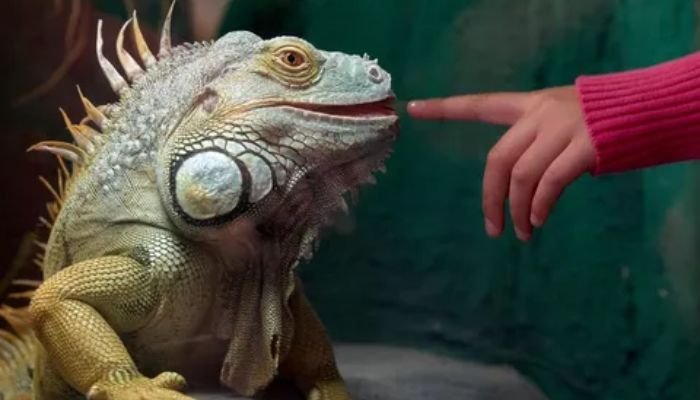
The enormous and well-known Green Iguana species inhabits the tropical rainforests of Central and South America. Its brilliant green coloration makes it one of the most recognizable reptiles on earth. As arboreal animals, green iguanas spend a great deal of time in trees. They primarily consume leaves, fruits, and flowers because they are herbivorous. Due to their exceptional adaptability, these iguanas can survive in a wide range of habitats, including mangroves, woodlands, and even cities.. Here are Green iguana Guide on Food, Habitat, Size, Lifespan & Predators below-
Green iguana Stats in Table format
The stats are given below for the Green iguana
| Reptiles List | Green Iguana |
|---|---|
| Family | Iguanidae |
| Type | Lizard |
| Size | Large |
| Length | Green iguana: Up to 4-6 feet (1.2-1.8 meters) |
| Color | Green iguana: Typically has a bright green coloration. |
| Weight | Green iguana: Adult green iguanas can weigh between 10 to 20 pounds or more.. |
| Lifespan | 10-20 years (or more) |
| Reproduction | Oviparous, lays eggs |
| Gestation Periods | The gestation period for a green iguana is approximately 65-75 days. |
| Endangered Status | Least Concern (IUCN Red List) |
| Features | Crest of spines along the back, excellent swimmers |
| Country & Areas | Central and South America, including countries such as Mexico, Belize, Costa Rica, Panama, Colombia, Venezuela, and Brazil. |
Green iguana Natural Habitat and Distribution
The Green Iguana is a reptile endemic to the tropical regions of Mexico, the Caribbean, and southern Brazil. They are found in a broad variety of ecosystems, from forests to mangrove swamps to savannas and even coastal areas within their range. Florida, Puerto Rico, and Hawaii are just some of the non-native places where these intrepid reptiles have been introduced.
Green Iguana Physical Features and Adaptations
Here are some other information about Green iguana:-
Body Structure:
Green iguanas are huge, slender lizards that live in trees. Their limbs are strong and their bodies are long. Adult males can reach a length of up to 6 feet, tail included, while adult females are often a bit shorter. Their long, powerful tails are essential for stability and provide a potent defensive mechanism.
Coloration and Patterns:
Green iguanas are primarily green, as their name suggests, which helps them blend in with the verdant greenery of their natural habitat. However, they can look anywhere from bright green to dark brown, depending on their disposition and other external variables. Green iguanas have a distinct blue phase as juveniles, but their coloring fades as they get older.

Defense Mechanisms:
Green iguanas have evolved some very impressive protection measures to help them stay safe from potential threats. Their main strategy is to quickly retreat and climb trees. If cornered, though, they are capable of inflicting harm with a whipping strike from their muscular tails. If a Green Iguana feels threatened, it can expand its body and extend its dewlaps (throat fans) to make itself look bigger and scarier to potential predators.
Green Iguana Diet and Feeding Habits
Here are some other information about Green iguana:-
Diet Type:
Since they are mostly herbivores, green iguanas eat only plants. Their digestive processes are perfectly adapted to digest tough plant matter.
Preferred Food Sources:
Green iguanas eat a wide range of plant life in the wild, from leaves and flowers to fruits and soft stems. They may change their diet to suit the resources they have access to, earning them the name “opportunistic feeders.”
Feeding Schedule:
Diurnal animals, like Green Iguanas, are awake and about during daylight hours. They prefer to hunt for food in the early morning and late afternoon, making them crepuscular feeders.
Green iguana Housing and Enclosure Requirements
Here are some other information about Green iguana:-
Terrarium Size and Setup:
Green iguanas depend on owners to provide a safe habitat for them. Iguanas can be housed in smaller enclosures when they are young, but as they mature, they will need more area. If you want to keep a full-grown Green Iguana, you’ll need a cage that’s at least 12 feet long, 6 feet high, and 6 feet wide.
Substrate Options:
The substrate in the cage should be picked with care to ensure the animal is comfortable and can keep itself clean. Newspaper, reptile carpet, and artificial turf are all good choices because they are easily cleaned and provide no risk of ingestion.

Temperature and Lighting:
Ectothermic means that the Green Iguana must rely on external heat sources to maintain a comfortable internal temperature. A temperature difference of about 27 degrees Celsius (80 degrees Fahrenheit) between a basking spot and the rest of the enclosure is recommended. Vitamin D3, necessary for calcium metabolism and general health, cannot be synthesized without exposure to UVB radiation.
Humidity and Water Needs:
The ideal humidity for a green iguana’s survival is between 70 and 90 percent. Humidity levels should be kept between 60% and 80% year-round. Green iguanas may take in water through their skin, therefore it’s important to provide them with a shallow water dish for drinking and soaking as well.
Green iguana Behaviour and Temperament
Here are some other information about Green iguana:-
Activity Levels:
Green iguanas are primarily nocturnal and can be seen up in the trees during the day. They are expert climbers, using their strong limbs and long tail to swiftly traverse the treetops.
Social Behaviour:
Green iguanas in the wild display both territorial and sociable behaviour, the latter of which is influenced by the proximity of food sources. They may use the same basking spots, but during mating season or while defending territory, they can become rather aggressive.
Handling and Taming:
Green iguanas can become accustomed to humans, but they are not pets and may still be nervous around you. Taming and handling an animal properly takes time and requires a cautious, respectful approach that acknowledges the animal’s autonomy.
Green iguana Breeding and Reproduction
Here are some other information about Green iguana:-
Mating and Courtship Rituals:
During the wet season, when food supplies are plentiful, Green Iguanas typically breed. To entice potential mates during courtship, men may engage in head-bobbling and push-up actions. When a female is fertile, mating takes place and an egg is fertilized.
Incubation and Hatchlings:
Green iguana females dig burrows or shallow holes on the earth to deposit their egg clutches. Depending on the temperature and humidity, the incubation period might be anywhere from 65 days to 90 days. When they first emerge from their eggs, baby animals are completely on their own to face the world for the first time.
Green iguana Common Health Issues and Veterinary Care
Here are some other information about Green iguana:-
Respiratory Infections:
Green iguanas are susceptible to respiratory diseases if they are housed in unsuitable conditions with low humidity. Wheezing, nasal drainage, and fatigue are all symptoms. Rapid access to veterinary treatment is crucial in these situations.
Parasites:
Green iguanas are susceptible to parasite infestations both internally and externally, which can lead to health issues and pain. In order to detect and cure parasitic infestations, routine veterinarian checkups and fecal examinations are required.
Metabolic Bone Disease:
Green iguanas in captivity frequently suffer from metabolic bone disease (MBD). Weakened bones and skeletal abnormalities are the end result of a lack of calcium and/or vitamin D3. MBD can be avoided with the use of UVB lighting and a calcium-rich diet.
Importance of Regular Vet Check-ups
Green Iguanas, like all animals, benefit greatly from routine veterinary examinations. A specialized reptile vet can examine the iguana, administer any vaccines it needs, check for parasites, and advise you on how to care for it properly. These intriguing reptiles can benefit greatly from preventative treatment to extend their lives and improve their quality of life.

Conclusion
The emerald Iguana’s eye-catching emerald coloring, amazing physique, and fascinating habits make it an attractive reptile. They are endemic to the tropical regions of Central and South America, but their ability to thrive in a broad variety of environments has piqued the interest of herpetologists everywhere.
FAQs
Q: What is the family and Type of an Green iguana?
A: The Green iguana is a species of family Iguanidae. The Famous Green iguana is a member of the family Lizard.
Q: What is the average size of an Green iguana?
A: The average adult Green iguana is Large between Green iguana: Up to 4-6 feet (1.2-1.8 meters).
Q: How long can an Green iguana grow in size in lengths?
A: Green iguana is Large in size and The green iguana can grow to be as long as 4-6 feet or 1.2-1.8 meters.
Q: What colors do Green iguana come in?
A: The green iguana is known for its vibrant green coloration..
Q: How big can an Green iguana get in weight?
A: The adult green iguana is known to have a weight range of 10 to 20 pounds or even more.
Q: What are the special Features of an Green iguana?
A: Green iguana are Crest of spines along the back, excellent swimmers
Q: How long do Green iguana live?
A: The usual lifespan of an Green iguana is The green iguana has a lifespan of approximately 10-20 years, although some individuals may live even longer.
Q: What food does the Green iguana eat?
The green iguana gets the vast majority of its nutrition from plants like leaves, flowers, and fruit. They subsist solely on plant matter and a high-fiber diet. On occasion, they will eat insects and small vertebrates. They need to eat a wide variety of foods to get the vitamins and minerals they need.
Q: What is the best habitat for an Green iguana?
A spacious cage that is representative of the green iguana’s native habitat is ideal. The ideal temperature range would be 80–95 degrees Fahrenheit, with a basking area of 95–100 degrees Fahrenheit. The enclosure should include UVB illumination to supply the UV radiation needed for vitamin D production. The iguana needs a variety of branches and rocks to climb on for exercise and exploration. A cleanable substrate and a water supply for drinking and soaking are important necessities in the enclosure. In addition, there should be enough of area for the iguana to roam around in its habitat.
Q: How do Green iguana give birth?
A: Green iguana are Oviparous, lays eggs
Q: How long is the gestation period for an Green iguana?
A: The gestation period of an Green iguana is approximately The gestation period for a green iguana is approximately 65-75 days.
Q: What is the natural behavior of an Green iguana?
Most green iguanas are found in The green iguana’s normal habit includes both arboreal and terrestrial pursuits. They spend most of their time in trees, where they use their powerful limbs and sharp claws to get about. Excellent swimmers, they frequently take to the water to avoid predators or cool down. Herbivores including leaves, fruits, and flowers make up the bulk of a green iguana’s diet. They are notoriously territorial and will resort to aggressive measures to protect their turf. During the mating season, males fight over territory and exhibit their vivid colors and rapid head motions to attract females. Green iguanas are often solitary animals that engage in a wide variety of actions to ensure their own success and that of their offspring in the wild.
Q: Is the Green iguana endangered?
A: The Green iguana is Least Concern (IUCN Red List).
Q: What are the prey of Green iguana?
The green iguana eats a wide variety of plants, including leaves, flowers, and fruits. In addition to reptiles and amphibians, they have been seen eating insects, spiders, and small vertebrates like birds and rodents. Green iguanas have also been seen eating carrion and eggs. Their diet is mostly made up of plants and tiny animals.
Q: Do Green iguana have any Predators?
It’s true that green iguanas Birds of prey like hawks and eagles, as well as huge snakes like the boa constrictor, are among the green iguana’s natural predators. Mammals like jaguars and ocelots, as well as larger lizards like the tegu, are also potential threats. The green iguana is preyed upon by both natural predators and humans for food and clothing.
Q: How Fast Does Green iguana Move?
A: Green iguanas can move at speeds of up to 21 miles per hour.
Q. What is Bite Force of Green iguana in PSI?
A. Bite Force in PSI of a green iguana is not available as they do not have strong biting capabilities.
Q: Can we keep Green iguana as pets?
In response to your question: A, green iguanas can be kept as pets. A big cage with heating and lighting, food rich in vegetables and fruits, and routine veterinarian care are all necessities for these animals. Pet owners should do their homework, as these reptiles can reach lengths of 6 feet and have unique requirements.
Q. Are Green iguana venomous?
Iguanas (green iguanas) are not poisonous, so answer no. The Central and South American home of these massive herbivorous reptiles. They have no venom glands and cannot manufacture venom, yet they can defend themselves with sharp teeth and powerful tails.
Q. Are Green iguana good for pest control?
A. Green iguanas are not typically used for pest control because they eat mostly plants, fruits, and flowers. Insects and other little pests aren’t something they normally prey on. In fact, when green iguana numbers are too high, they might be considered pests themselves because of the harm they can do to gardens and crops.
Q. Do Green iguana require a UVB light source?
Green iguanas, like all iguanas, need to be exposed to UVB light in their environment. They need UVB sunshine to properly metabolize calcium and keep their bones growing, making it crucial to their health. In the wild, they soak up the sun to acquire their daily dose of UVB rays. Health problems like metabolic bone disease can be avoided, along with correct diet and housing, by providing a UVB sun source for captive animals.
I hope you like reading on Green Iguana FAQ Guide on Food, Habitat, Size, Lifespan and Predators.
